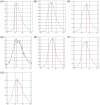In vitro hyperspectral analysis of tattoo dyes
- PMID: 36704880
- PMCID: PMC9838748
- DOI: 10.1111/srt.13268
In vitro hyperspectral analysis of tattoo dyes
Abstract
Background: There is no method that can guarantee effective, quick, and noninvasive removal of tattoo dyes. Laser methods are considered to be the method of choice. In this study, an attempt was made to determine the in vitro spectral characteristics of selected dyes used in permanent makeup and tattoos and to analyze the obtained parameters in terms of laser treatments optimization.
Materials and methods: Hyperspectral analysis was performed to determine the spectral characteristics of the dye on the entire surface of the slide. Seven dyes used in permanent makeup and tattoos were analyzed in vitro. The maximum reflectance and the wavelength for a given dye were determined for the maximum reflectance in the studied wavelength range: 400-1000 nm. The optical properties of the dyes were determined based on visible light imaging using camera.
Results: The maximum radiation reflectance ranges from 634 to 732 nm for the tested dyes. Visually very similar colors may differ significantly in the wavelength for which the maximum absorption of the radiation occurs. White and yellow dyes are characterized by the highest reflectance value. The black dye is characterized by the lowest reflectance coefficient. Low reflectance of black dye results in more safe and effective removal treatments.
Conclusion: The homogeneity of radiation absorption can be identified using methods of analysis and processing of images in visible light. Optimization of the wavelength of which the maximum absorption/reflectance of radiation occurs may allow us to increase the effectiveness of laser treatments for removing permanent makeup and tattoos.
Keywords: hyperspectral analysis; radiation reflectance; tattoo; tattoo dye; tattoo removal.
© 2022 The Authors. Skin Research and Technology published by John Wiley & Sons Ltd.
Conflict of interest statement
The authors declare that there is no conflict of interest that could be perceived as prejudicing the impartiality of the research reported.
Figures










Similar articles
-
Skin reflectance-guided laser selections for treatment of decorative tattoos.Arch Dermatol. 1996 Apr;132(4):403-7. Arch Dermatol. 1996. PMID: 8629843
-
Laser Treatment of Tattoos: Basic Principles.Curr Probl Dermatol. 2017;52:94-104. doi: 10.1159/000450809. Epub 2017 Mar 10. Curr Probl Dermatol. 2017. PMID: 28288450
-
Flat Warts (Verrucae Planae) Confined to the Pigment of a Tattoo: A Rare Tattoo-associated Complication.Acta Dermatovenerol Croat. 2023 Nov;31(2):112-114. Acta Dermatovenerol Croat. 2023. PMID: 38006375
-
Laser tattoo removal: laser principles and an updated guide for clinicians.Lasers Med Sci. 2022 Aug;37(6):2581-2587. doi: 10.1007/s10103-022-03576-2. Epub 2022 May 23. Lasers Med Sci. 2022. PMID: 35604505 Review.
-
Laser removal of tattoos.Am J Clin Dermatol. 2001;2(1):21-5. doi: 10.2165/00128071-200102010-00004. Am J Clin Dermatol. 2001. PMID: 11702617 Review.
Cited by
-
Hyperspectral Imaging Database of Human Facial Skin.Appl Spectrosc. 2025 Feb;79(2):328-344. doi: 10.1177/00037028241279323. Epub 2024 Sep 24. Appl Spectrosc. 2025. PMID: 39314060 Free PMC article.
References
-
- Stirn A, Hinz A, Brähler E. Prevalence of tattooing and body piercing in Germany and perception of health, mental disorders, and sensation seeking among tattooed and body‐pierced individuals. J Psychosom Res. 2006;60(5):531‐534. - PubMed
-
- Laumann AE, Derick AJ. Tattoos and body piercings in the United States: a national data set. J Am Acad Dermatol. 2006;55(3):413‐421. - PubMed
-
- Sweeney SM. Tattoos: a review of tattoo practices and potential treatment options for removal. Curr Opin Pediatr. 2006;18(4):391‐395. - PubMed
MeSH terms
Substances
Grants and funding
LinkOut - more resources
Full Text Sources

